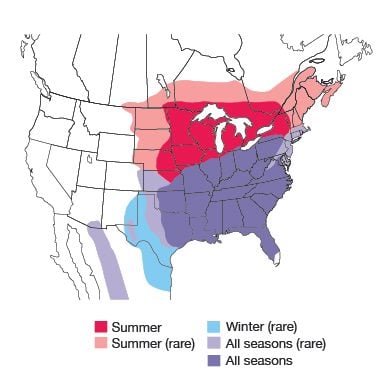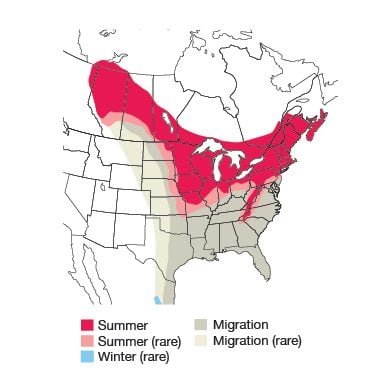We’re delighted to announce that these three amazing videos were chosen as the winners of the 2024 Building for the Birds Video Contest. Congratulations to the winners!
Want to be a winner? Check out our current contests and promotions and submit your best photos and videos!
First Place
Mark Lee of Garner, North Carolina, won first place for a video showing how he crafted the Wonder Feeder for his wife, who enjoys feeding the backyard birds.
Second Place
Paula Eliasek of Charlottesville, Virginia, won second place for a video that showcases a clever elevated method for feeding birds from an upper deck that overlooks a backyard with a steep slope.
Third Place
Vincent Quattrocchi of Montrose, Pennsylvania, won third place for his video showcasing his high quality handcrafted birdhouses.
See the amazing winner of the 2023 Birds & Blooms Photo Contest.
On This Page
What Does an Eastern Bluebird Look Like?

Scientific Name: Sialia sialis
Family: Thrush
Length: 7 inches
Wingspan: 13 inches
One look at an eastern bluebird with its vibrant colors, and it’s easy to see why the birds rank near the top of any list of best-loved birds. Classified as thrushes, a family found worldwide, bluebirds are unique to North America. Male bluebirds are more brightly colored than females, and juveniles wear a pattern of spots, reflecting their thrush ancestry.
Eastern bluebirds are easy to identify by their upright posture, color pattern and thin, straight bills. Adult males are deep blue on the head, back, wings and tail; rusty orange on the chest; and white on the lower belly. Adult females have the same pattern in muted colors.
Learn how to identify mountain bluebirds and western bluebirds.
What Do Eastern Bluebirds Eat?

Insects make up most of their summer diet. You may attract bluebirds to your backyard feeders with live mealworms, but the best methods involve foods in nature. Bluebirds feed heavily on insects they find on or near the ground, so avoid treating your lawn with chemicals. During the colder months they birds wander in flocks and eat mainly fruits and berries. Planting native trees and shrubs that bear fruit is a wonderful way to provide food.
They also love bird baths, and if you can make the water move—even if you just add a small dripper—that’s better still.
Eastern Bluebird House

Prepare your backyard to welcome an eastern bluebird family. These birds start house hunting early, so clean out last year’s birdhouse in late winter or early spring. Make sure the bluebird box is mounted about 5 feet off the ground with a predator guard on the post to keep intruders from climbing up. Place it in an open, sunny area, preferably facing a field. The entrance hole should measure 1 1/2 inches in diameter.
You can make a DIY bluebird house or buy one. For plans and dimensions, consult the North American Bluebird Society website. Make sure it is is designed to be easily opened for cleaning.
Learn how to monitor bluebird nest boxes to make sure house sparrows do not take over.
Nest and Eggs

A male eastern bluebird attracts a female by drawing her to his nest site by fluttering his wings and carrying material back and forth through the hole. Once two bluebirds have paired up, the female builds the nest herself in a tree cavity or birdhouse out of grasses and pine needles. She lays four to six pale-blue or white eggs.
Eastern Bluebird Song
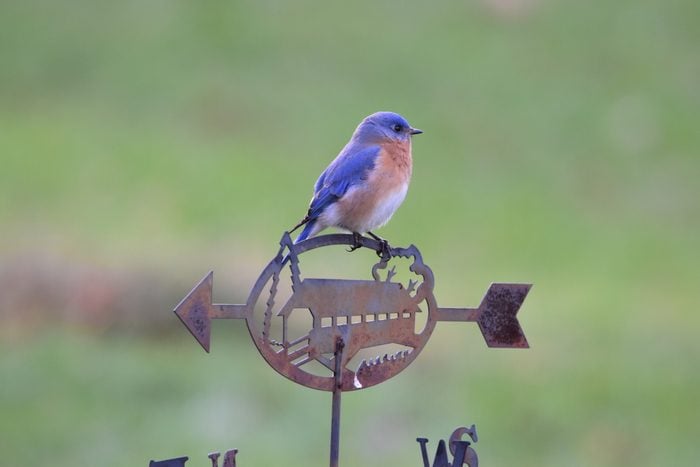
Listen to the eastern bluebird’s song. Their voice is a soft warble: “tru-al-ly, tru-al-ly.”
Bird songs provided by the Cornell Lab of Ornithology.
Don’t miss 20 beautiful pictures of bluebirds.
Range Map and Habitat

The eastern bluebird is the most widespread bluebird in North America. In summer, it lives throughout southeastern Canada and in the United States east of the Rocky Mountains. A separate population is found from southern Arizona through Mexico and into Central America. These songbirds live in open habitats, such as backyards and farmland.
Psst—here’s what it means if you see a bluebird.
Many eastern bluebirds migrate in fall, and the species becomes more common in central and southern states in winter. A few stay through the cold months, as far north as Canada. These wintering bluebirds move around the countryside in small flocks, gathering to feed on the fruits of poison ivy, dogwood, holly, and other vines and trees.
Range maps provided by Kaufman Field Guides, the official field guide of Birds & Blooms.
Next, learn how to tell the difference between a bluebird vs a blue jay.
Sources
- North American Bluebird Society
- All About Birds – eastern bluebird
On This Page
What Does an Eastern Kingbird Look Like?

For birders looking to add more flycatchers to their life list, the eastern kingbird is a good place to start. According to Dale Gentry, Director of Conservation for Audubon Upper Mississippi, it’s one of the easiest flycatchers to identify—and its behavioral patterns combined with its appearance make it a relatively quick ID.
“There are a couple of good clues [to identifying an eastern kingbird],” Dale says, noting that the birds are black-gray on their backs, the back of their heads, and most of their tail. From the underside, however, eastern kingbirds can appear mostly white. Dale says they’re solid white on their chin, breast, and belly. Males and females appear identical.

For an unimpeachable clue, Dale recommends getting a good look at the tail. “They have a white band at the end of their tail,” he says. “If you see a medium-sized songbird that’s dark gray on the back, white on the belly, and has a stark white tip to its tail, it’s a sure sign that you’ve got an eastern kingbird.”
Learn how to identify an eastern phoebe.
Eastern Kingbird Behavior

With the scientific name Tyrannus tyrannus and a knack for attacking much larger birds to defend its nest, the ultimate “king bird” might be the eastern kingbird. One of the so-called “tyrant flycatchers,” this is among the most regal of the bunch—although eight subspecies go by the kingbird moniker.
While tyrant carries a negative connotation, it’s worth noting that these birds’ scientific name isn’t a homage to a particularly cruel monarch. “They’re not named because they’re tyrants, but because they have a crown of different-colored feathers,” Dale says. “It’s interesting because you really don’t see it, but kingbirds have brightly colored feathers on their crown. The only time I’ve ever seen it is when I’ve seen a museum specimen.”
Eastern kingbirds are birds of the open sky. Perching high atop a tree, power line or shrub, they survey their surroundings for intruders and quickly dispatch them: you’ll often see them chasing away any bird that has the gall to intrude upon their kingdom. As an interesting behavioral quirk, Dale says eastern kingbirds tend to make noise when they fly. “If they’re singing, they’re frequently flying,” he says.
Meet the regal belted kingfisher bird.
Diet: What Do Eastern Kingbirds Eat?

As some might already know, eastern kingbirds swoop through the air to snag bugs in the summer. Their prominent perches provide easy access to flying insects such as wasps, crickets, and flies. As do most others in the flycatcher family, these kingbirds sport whiskery feathers to help funnel bugs into their gaping mouths.
Surprisingly, eastern kingbirds swap out their personal menus during winter. That’s a unique trait among birds, according to Dale. “What’s really interesting is a discovery that came out when I was in graduate school,” he explains. “We found that in winter, these kingbirds migrate down to the tropics and their diet becomes fruit-eating. It’s really remarkable that they go from an insect-eating bird to a fruit-eating bird.”
Range and Habitat

The eastern kingbird is ever-present in summer over the eastern two-thirds of North America, often perching on fences or roadside wires. It is the only kingbird with a widespread range in the East. During summer in the Great Plains its range overlaps with that of the western kingbird, which has similar habits but different colors, including a bright yellow belly.
To find this bird, Dale recommends searching at the edges of wooded areas. However, don’t venture too far down the trail. “They like small woodlots and small, wide-open deciduous habitats, golf courses, those sorts of things,” he says. “They’re happiest when they’ve got forest near the edge of an open clearing, or a meadow. Even in agricultural fields, they’ll do OK.”
Call and Sounds
Bird sounds courtesy of the Cornell Lab of Ornithology
You might first notice an eastern kingbird from its buzzy, sputtering cries as it flies overhead. Dale categorizes the birds’ song as “speedy” and explains how he remembers its vocalizations. “Their song was described to me by my ornithology professor as someone with a handheld cassette player on fast-forward,” he says.
Nesting Habits
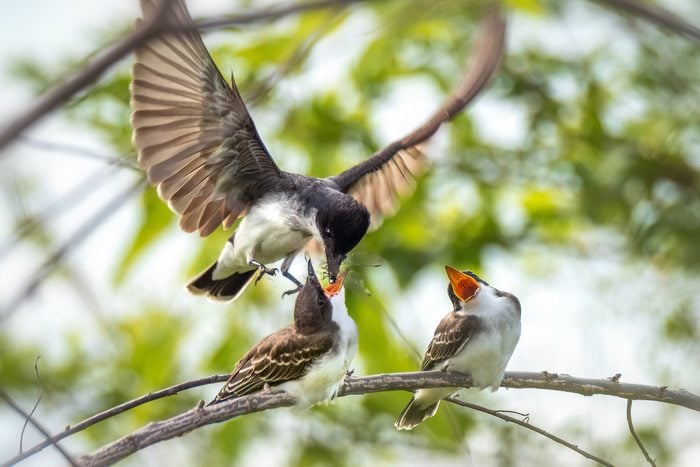
One reason these birds are called kingbirds derives from their tireless defense of their nests. Famed for their fearless and commanding behavior, they attack much larger birds that get too close—crows, hawks and even eagles.
Female eastern kingbirds take on almost all nest-building duties. A typical brood consists of two to five eggs, which serve as the only young for a pairing during a single breeding season. Young kingbirds that have flown the nest can remain dependent on their parents for food for seven weeks. “They don’t leave the nest until they’re capable of flying, so you’d only see a juvenile in the first few weeks of its life,” Dale says.
Juvenile Eastern Kingbird

“I can’t seem to find this species in my bird book. Can you help me?” asks Birds & Blooms reader Kayla Bissett of Mayville, Michigan.
Birding experts Kenn and Kimberly Kaufman say, “A frequent sight in open stretches of eastern North America in summer, this is an eastern kingbird. It is a relatively plain bird, with a charcoal gray back, a slightly darker top of the head, and whitish throat and underparts. The key field mark is the white band at the tip of its black tail. The one in your photo looks like a juvenile, with pale feather edges on its lower back and a white tail band narrower than on adults.
From a distance, the dark back appears paler, while the paler belly appears darker, making the birds more difficult to spot. This coloration is known as countershading, a form of camouflage.”
About the Experts
Dale Gentry has more than 25 years of experience working in conservation. He has conducted bird surveys in Minnesota forests, taught community ecology and conservation biology to graduate students, and led conservation-biology student trips to Costa Rica and the Galapagos Islands. In his current role, he serves as Audubon Upper Mississippi River’s Director of Conservation. He holds a bachelor’s degree in zoology from Idaho State University, a master’s degree in biology from the University of South Dakota, and Ph.D. in Atmosphere, Environment and Water Resources from the South Dakota School of Mines and Technology.
Kenn and Kimberly Kaufman are the official bird experts for Birds & Blooms. They are the creators of the Kaufman Field Guide series and they lead birding trips all over the world.
Sources
- Cornell Lab of Ornithology – eastern kingbird
- National Audubon Society – eastern kingbird
- Audubon, Guide to North American Birds
On This Page
What Does a Lincoln’s Sparrow Look Like?

Birds & Blooms reader Colleen Gibbs of Coon Rapids, Minnesota, wrote to birding experts Kenn and Kimberly Kaufman after seeing a mysterious sparrow in her yard. They explained how to identify a Lincoln’s sparrow. Colleen says of the new visitor, “This bird is similar to several other types of sparrows, but it doesn’t seem to match any exactly. What is it?”
Kenn and Kimberly say, “With a beautiful, clear photo such as yours, we have plenty of clues to check. This bird is a Lincoln’s sparrow, an uncommon species in your area that is often shy. Its colors are helpful for checking its identity: The face is mostly gray, with reddish brown stripes along the sides of the crown, a buff mustache mark and a narrow buff eye ring. The chest is also buff with narrow black streaks.”
Learn how to identify and attract a chipping sparrow.
Similar Species
Kenn and Kimberly say, “The bold black spot on the (Lincoln’s sparrow’s) chest might be confusing since that’s sometimes considered a field mark specifically for song sparrows, but actually many other sparrows can show that mark.”
Lincoln’s Sparrow Range
Lincoln’s sparrows can be seen in most areas of the United States and Canada, but can be very uncommon depending on the location and time of year. They are less frequently spotted in the eastern U.S.
In summer, these sparrows breed in Canada, the far north, and parts of the mountain west. For a larger chunk of the U.S., the Lincoln’s can be spotted during spring and fall migration.
Look for them in winter in the south, from Florida to Texas, west to Southern California, along the Pacific coast, and in Mexico. Some birds stay as far north as Arkansas, Oklahoma and Missouri.
They travel in mixed flocks during migration, so keep your binoculars handy in spring and fall.
Diet: What Does a Lincoln’s Sparrow Eat?

These small, striped ground-foraging birds spend a good portion of their time in dense cover. To attract them to your backyard, plant plenty of shrubs and trees. The branches offer the security that the sparrows need. Also, native plants encourage healthy insect populations for the sparrows to gobble up. Grow seed-bearing plants for these sparrows to feed on during winter.
Next, learn how to identify a white throated sparrow and an American tree sparrow.
Lincoln’s Sparrow Song and Call
Bird sounds courtesy of the Cornell Lab of Ornithology
Male Lincoln’s sparrows have a very musical song. It’s a rich mix of trills and buzzy notes and lasts for about two seconds. Both males and females belt out a tinny high-pitched call and a series of chips.
About the Experts
Kenn and Kimberly Kaufman are the official bird experts for Birds & Blooms. They are the creators of the Kaufman Field Guide series and they lead birding trips all over the world.
Sources
On This Page
What Does a House Sparrow Look Like?

The male house sparrow has a gray and rusty crown with pale cheeks and a black bib; the female is rather plain with dusty brown overall coloring, strong stripes on her back and patches of pale feathers behind her eyes.
Discover more types of sparrow birds that you should know.
Are House Sparrows Invasive?

Yes, house sparrows are an invasive bird species. A nonnative to North America, they were introduced from Europe to New York in 1852. Birders tend to dislike them because they often kill native birds in order to take over their nesting sites (i.e. bluebird boxes or purple martin houses).
If you notice that house sparrows are having a negative impact on native birds nesting in your yard, there are methods you can employ to discourage them. Since they are invasive, it is legal to remove their nests. You might also try plugging the birdhouse hole until the sparrows move on. It may take multiple attempts to discourage them from nesting in your yard, as they are known to be persistent.
Project NestWatch also provides advice for trapping and humanely euthanizing these nonnative birds.
Psst—don’t confuse house sparrows with our native sparrows.
What Do House Sparrows Eat?

These birds have a plant-based diet and tend to focus on seeds; they especially enjoy cracked corn and millet. They also might munch on flower petals or leaves. House sparrows aren’t particularly picky about what they eat, though — you may find them everywhere from at your feeders to munching on crumbs on the grounds of an outdoor restaurant.
To get rid of them, put your feeders away until they move on. House sparrows won’t stick around where there isn’t an easy food source.
Learn fascinating facts about sparrows.
House Sparrow Call and Sounds
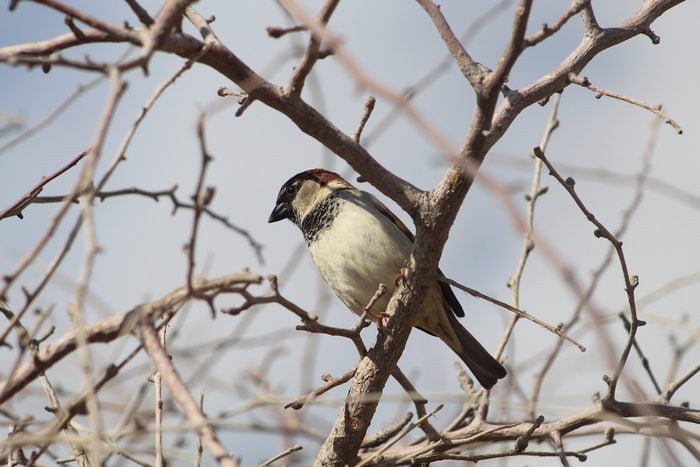
This species is not known as a particularly musical songbird. House sparrows give a short, simple chirp call.
Bird sounds courtesy of the Cornell Lab of Ornithology
Learn how to identify wrens vs sparrows.
House Sparrow Nesting Habits

Nests tend to be loosely built and messy, incorporating typical nesting materials like twigs as well as scraps of general debris. They typically nest in cavities in trees or other structures, but they’ll occasionally build their nests in more open, unusual spaces like streetlights or gas station roofs.
House sparrows build nests year-round. They display fierce aggression during nesting season and compete with other birds for nesting sites, especially bluebirds.
Range and Migration

Birds & Blooms reader Juli Seyfried asks, “The sparrows nesting under our roof overhang left during fall. Where did they go?”
Birding experts Kenn and Kimberly Kaufman say, “House sparrows, which were introduced to North America, often nest in the crannies and holes around the eaves of houses, unlike native sparrows.
Although house sparrows are not migratory, they do move around with the seasons. After they finish nesting and raising young, they usually gather in small flocks and roam the neighborhood or countryside. Throughout the winter, the flocks concentrate wherever they find a good supply of food.”
Next, learn how to identify a chipping sparrow.
About the Experts
Kenn and Kimberly Kaufman are the official bird experts for Birds & Blooms. They are the creators of the Kaufman Field Guide series and they lead birding trips all over the world.
Sources
- Project NestWatch
- North American Bluebird Society – house sparrow control
- All About Birds – house sparrow
On This Page
What Does a Dark-Eyed Junco Look Like?

Scientific Name: Junco hyemalis
Family: Sparrow
Length: 6 inches
Wingspan: 9 inches
Markings: Coloration varies regionally. Common characteristics are dark eyes, pink beaks, white-edged tails and black, brown or gray hoods.
The name “dark-eyed junco” applies to several populations, each with slightly different coloring. The slate-colored is the only junco in the East. The Oregon subspecies is the most widespread in the West; others with smaller ranges are the pink-sided, white-winged, gray-headed and red-backed. If you live in the West or are visiting in winter, it’s worth your while to look in a field guide so you know what you might see.
Don’t miss these adorable junco bird pictures.
Female and Juvenile Juncos

In most of the populations, female juncos are slightly lighter than the average male. Female slate-colored juncos, for instance, tend to be brown, while their male mates are closer to black. Juvenile juncos are often lighter and can be streaked.
Discover 8 cool facts about junco birds.
Diet: What Do Dark-Eyed Juncos Eat?

Juncos are seedeaters. In winter, juncos feast on seeds of weeds and grasses that are left standing in your landscape or in fields, parks and open woodlands. Seeds from common plants such as chickweed, buckwheat, lamb’s-quarters and sorrel make up 75 percent of their year-round diet. Or they may snatch a juicy berry from a fruit-producing shrub.
But juncos also supplement their diet with feeder foods. These snowbirds prefer to forage on the ground for millet, black-oil sunflower seed or cracked corn that has fallen from your feeders. They may occasionally take a seed from a platform or tray feeder.
Did you know: Some ground birds are considered hoppers while others are walkers. What about juncos? They’re hoppers!
Dark-Eyed Junco Nest and Eggs

Although juncos nest mostly in Canada and parts of Alaska, there are some year-round residents in pockets of the Lower 48, including the Northeast, the Northwest and the California coast.

The female constructs a cup-shaped nest on the ground using natural materials and then lays four to six pale, speckled eggs inside.
Junco vs chickadee: Here’s how to tell the difference.
Dark-Eyed Junco Song
Listen to the dark-eyed junco song. Their voice trills vary in pitch and tempo, from dry notes to tinkling sounds.
Bird songs provided by the Cornell Lab of Ornithology.
Range Map and Habitat
Dark-eyed juncos, also known as snowbirds, are thriving! Our friends at the Cornell Lab of Ornithology estimate their total population to be more than 630 million.
Juncos are common winter visitors across much of the United States. They travel in small flocks during the season. Juncos reappear in many parts of the Lower 48 just as winter comes alive each year. They leave their breeding grounds in the Northwoods and the western mountains. Then they descend on backyard feeding stations across much of the U.S.
Look for juncos in evergreen or mixed forests in summer. In winter, they visit all kinds of woods, brushy places, farms, parks, and backyards.
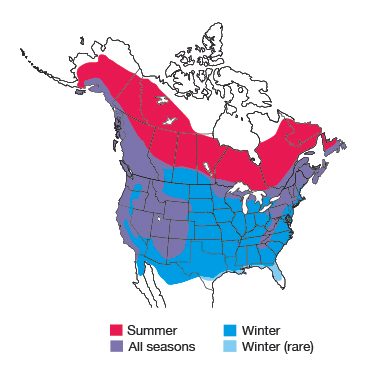
Range maps provided by Kaufman Field Guides, the official field guide of Birds & Blooms.
Next, learn how to identify and attract a chipping sparrow and a white throated sparrow.
Sources
On This Page
What Does a White-Throated Sparrow Look Like?

Birding experts Kenn and Kimberly Kaufman say, “Clues to help you identify a white-throated sparrow include the small white throat patch, the yellow in front of the eye, and the rich reddish-brown on the shoulder and wing. Some white-throated sparrows have bold stripes of white and black on the head. Others have stripes of tan and dark brown.
People used to think that the tan-striped birds were young ones. But that’s not necessarily true. About half of all adult white-throated sparrows, both males and females, are tan-striped for life.”
White-throated sparrows measure 6-3/4 inches with a wingspan of 9 inches. When identifying sparrows, take note of face pattern, any streaking on the belly, and habitat.
Meet the white-crowned sparrow.
White-Throated Sparrow Song
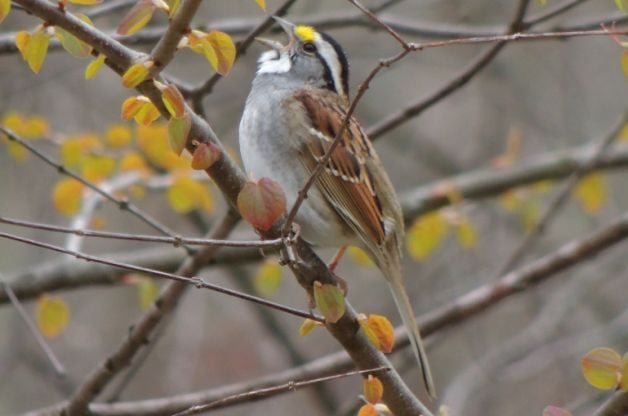
White-throated sparrows sing a pretty, pure whistling song. While some birders hear Oh sweet Canada Canada Canada, others think it sounds more like Old Sam Peabody Peabody Peabody.
Bird songs provided by the Cornell Lab of Ornithology.
Listen for the sweet sounds of a song sparrow.
Nests and Eggs
This sparrow builds a nest from fine materials on or near the ground; the female lays three to six blue to green eggs with reddish-brown specks.
Discover fascinating sparrow facts you should know.
What Does a White-Throated Sparrow Eat?

White-throated sparrows adore sunflower seeds and millet. You can also attract these birds by offering cracked corn. These lively birds grab seed from feeders or peck for morsels on the frosty ground below.
Away from feeders, they eat weed seeds, fruits, buds and insects.
Wren vs sparrow: what bird are you seeing?
Range Map and Habitat

These birds are common in gardens, residential areas, woodlands and clearings. White-throated sparrows are commonly seen in the East, but are much less common in the West.
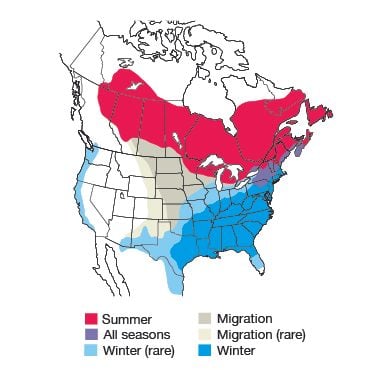
Range maps provided by Kaufman Field Guides, the official field guide of Birds & Blooms.
Next, discover learn all about dark-eyed juncos.
About the Experts
Kenn and Kimberly Kaufman are the official bird experts for Birds & Blooms. They are the creators of the Kaufman Field Guide series and they lead birding trips all over the world.
Sources
On This Page
Rose-Breasted Grosbeak Identification
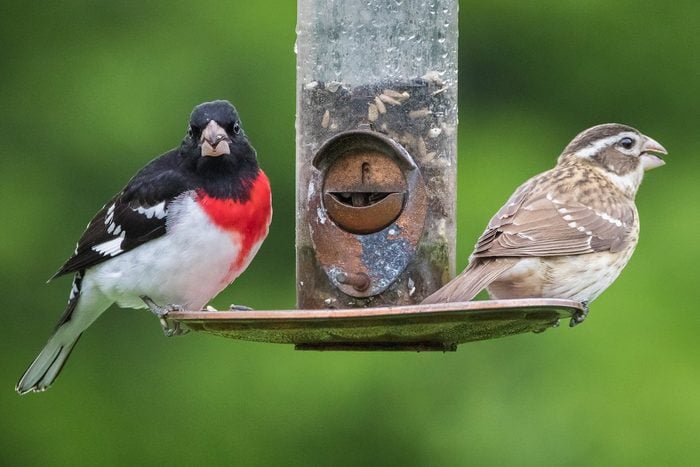
To some birders, spotting a rose-breasted grosbeak is a definite sign of spring. Rose-breasted grosbeaks show up east of the Rockies in spring. Males are dressed to the nines in black and white with a red ascot-like marking on their chests. Their bold feathers make them easy to identify. These birds measure about 8 inches long with a 12 1/2 inch wingspan.
Check out 5 types of grosbeaks backyard birders should know.
Female Rose-Breasted Grosbeak
Females sport a more subtle look and are harder to identify because of their drab coloring. They are brown and white with a striped breast and a dark cheek patch. Look for long white stripes above their eyes on a heavily streaked brown body with yellowish underwings. As different as they are, both share one easily recognizable feature: thick conical bills.
Don’t miss these outstanding pictures of rose-breasted grosbeaks.
Nests and Eggs

Pairs build a lightly woven cup shaped nests made of twigs, grasses and leaves. From late spring to summer, the female lays up to five bluish or greenish speckled eggs. Rose-breasted grosbeaks build their nests so loosely that the eggs they lay can occasionally be spotted through the bottom.
A nest is usually located on a tree branch 5 to 20 feet off the ground, but sometimes can be much higher and closer to the forest canopy. “Rose-breasted grosbeak nests are often very high in trees, so they can be hard to spot from the ground,” says Emma Greig, a project leader for the Cornell Lab of Ornithology’s citizen science program Project FeederWatch.
Both males and females spend time incubating the eggs and then quietly sing to each other. Eggs hatch in about 13 days under the watchful eyes of both parents. If a pair raises a second brood, the male may take charge of the first while his mate sits on the new eggs. Males and females share incubation, brooding and feeding duties.
Get to know gorgeous blue grosbeaks.
Juvenile Rose-Breasted Grosbeak

Immature birds are brown and heavily streaked. Young males look like a blend of a female and male with a white eyebrow and a less visible chest patch. Within two weeks, the chicks leave the nest.
Learn how to identify baby orioles and juvenile orioles.
What Does a Rose-Breasted Grosbeak Eat?

Rose-breasted grosbeaks mostly stick to foraging for insects, seeds and fruit in the foliage of trees, but they will come to backyard feeders. Make sure your feeders are full during migration months, when they’ll need the most energy. Draw in these timid, stocky birds by setting up several feeders filled with birdseed or peanuts. Be sure to provide generous perching room. “A great way to attract rose-breasted grosbeaks to your yard is to offer black oil sunflower seeds in a platform, hopper or large tube feeder,” Emma says.
Ensure that the young get a healthy start by offering a habitat filled with native plants that attracts a steady diet of insects. “Even though adult rose-breasted grosbeaks love seeds and berries, their young are fed mostly insects,” says Emma. “This is because the young need the extra protein for their growth.”
I have fed orioles for years but had an awesome surprise the day I took this photo (above). I was thrilled when rose-breasted grosbeaks showed up,” says Pam Garcia.
Did you know: evening grosbeaks and pine grosbeaks are winter visitors.
Attract Rose-Breasted Grosbeaks With Plants

You’ll have a better chance of attracting these fliers if you plant berry-producing trees and shrubs.
- American elderberry
- Arrowwood viburnum
- Blueberries
- Flowering dogwood
- Mountain ash
- Red mulberry
- Serviceberry
- Virginia creeper
Rose-Breasted Grosbeak Song
Their song is similar to an American robin’s whistle, but faster and more musical. Upon arriving around May from their wintering grounds in Mexico, Central America and northern South America, these songbirds kick off courtship. The males’ melodies are designed to attract mates, claim territory and warn off competitors. Males are known to sing more than 650 times per day. The male’s courtship dance can consist of the head tipped back and tail spread out and held upright while the bird flashes its rose-colored underwings.
Bird songs provided by the Cornell Lab of Ornithology.
Habitat and Range Map

Look for these birds in deciduous and mixed woods, also well-wooded residential areas and parks. They are primarily spotted in the eastern half of the country and are summer residents in northern states. Interestingly, they cross paths and sometimes mate with black-headed grosbeaks in the Great Plains, resulting in hybrid offspring.
Kenn and Kimberly Kaufman say, “Rose-breasted grosbeaks are mostly eastern birds, spending the summer in the northeastern U.S. and eastern Canada, and wintering from Mexico south through Central America to northern South America. Their main migration routes are east of the Rocky Mountains. But every year some stray from the normal routes used during spring and fall migrations, and they show up at scattered sites throughout the western states. This seems to happen most often in spring, probably involving birds that go off course as they move north out of Mexico.”
Range maps provided by Kaufman Field Guides, the official field guide of Birds & Blooms.
About the Expert
Emma Greig is the project leader of Project FeederWatch, a citizen science program, for the Cornell Lab of Ornithology. Emma holds a Ph. D. from the University of Chicago and previously was a postdoctoral associate in Macaulay Library.
Sources
On This Page
What Does an Evening Grosbeak Look Like?

It would be nearly impossible, even for beginner birders, to overlook a flock of evening grosbeaks. These robin-sized beauties—named for the mistaken belief that they appeared more often at dusk—aren’t always easy to find, though. Learn how to identify and attract an evening grosbeak.
Meet the 5 types of grosbeaks backyard birders should know.
Few bird species are as stunning as evening grosbeaks. Charlotte Demers, a researcher from the Adirondack Ecological Center in Newcomb, New York, describes them as “big, gorgeous birds.” The yellow, black and white feathers of the males truly stand out, while females are more yellow-gray in color. Males sport an almost comically bold unibrow. All grosbeaks share a common characteristic: a thick, conical bill for cracking tough seeds.
Learn how to identify rose-breasted grosbeaks.
Evening Grosbeak Facts

- Scientific Name: Coccothraustes vespertinus
- Family: Finch
- Length: 8 inches
- Wingspan: 13 inches
Check out the updated winter finch forecast.
Nest and Eggs

The female builds a shallow saucer-shaped nest from plant materials and lays two to five blue or turquoise speckled eggs.
What Do Evening Grosbeaks Eat?

Throughout the year, grosbeaks’ diets include everything from maple sap to caterpillars. Fruits, seeds and buds are important food sources too. During the winter, their large flocks readily feed on sunflower seeds.
Get to know gorgeous blue grosbeaks.
Best Bird Feeders for Evening Grosbeaks
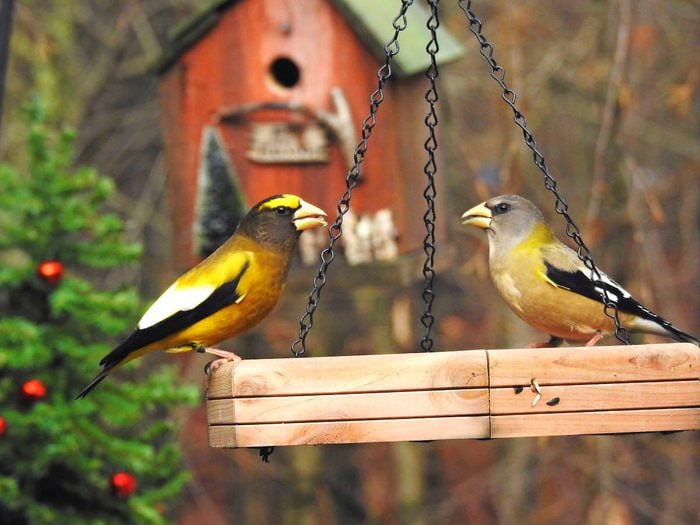
“Grosbeaks are too bulky for tubes, but you can get them on tray or platform feeders and hoppers,” Charlotte says. Dozens of evening grosbeaks will dine side by side during these feeding frenzies, while others flutter in from nearby treetops. Keep an eye on your backyard feeding station for this thrilling nature scene.
Evening Grosbeak Song and Call

Despite being classified as songbirds, evening grosbeaks don’t really have a song. They use chirping calls but don’t rely on singing to select a mate or defend their territory Listen for a sharp, high and trilling “kleerr” call.
Bird songs provided by the Cornell Lab of Ornithology.
Go west to see black-headed grosbeaks.
Evening Grosbeak Migration
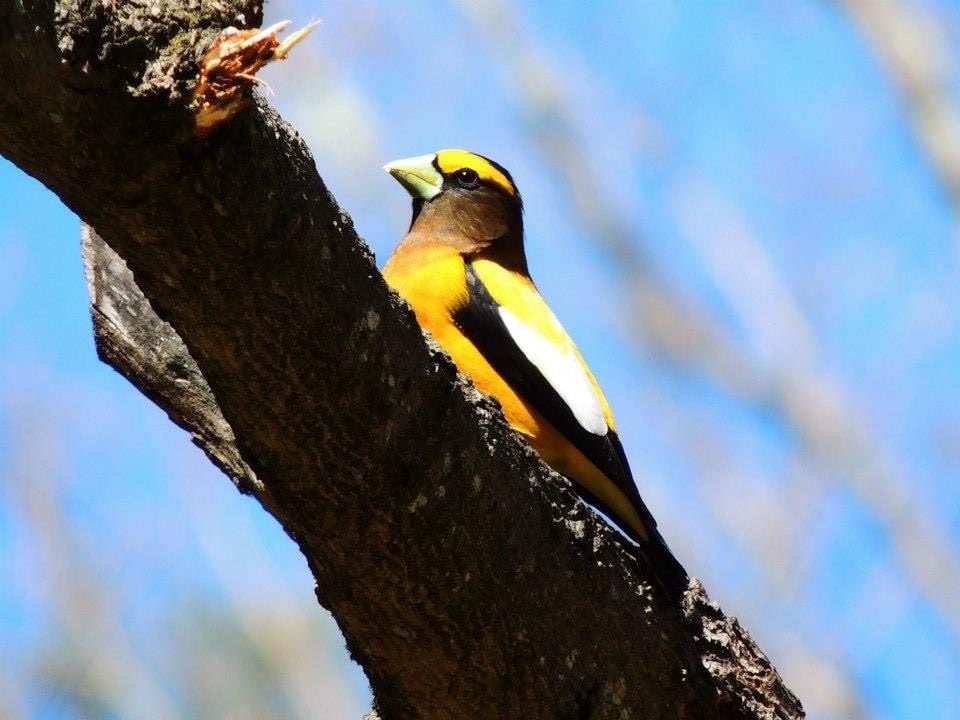
Evening grosbeaks are irruptive migrators, not following regular annual patterns of movement. Instead, huge numbers of the birds can move to a location but then not be seen again for years. One perk of this wandering lifestyle is usually abundant food resources where they arrive.
Charlotte sometimes finds grosbeak flocks “gritting” alongside roads. This curious behavior is when birds gather sand in their crops, which helps grind down the hard seeds and nuts that they eat.
Head up north to see pine grosbeaks.
Habitat and Range Map
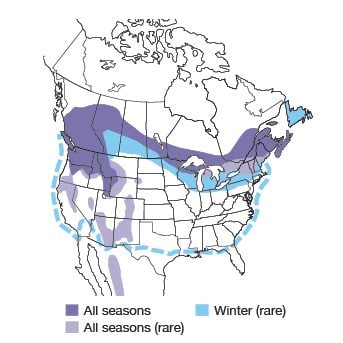
Range maps provided by Kaufman Field Guides, the official field guide of Birds & Blooms.
Evening grosbeaks are forest specialists found year-round across Canada and down into the western mountains of the U.S. The species expanded into New England during the early 1900s, perhaps following ornamental plantings of box elder trees.
Charlotte says multiple theories explain recent population declines in the East. One idea is that peak grosbeak numbers were artificially high after spruce budworm outbreaks. Another cause could be habitat loss. “They used to be here in winter in huge flocks of 30, 40 or even 50 birds,” Charlotte says, “but in our area they are getting harder to see.”
They are now uncommon in the Northeast and Midwest, unless you get lucky during an irruption year, but still common in Oregon and other parts of the west.
About the Expert
Biologist Charlotte Demers is a researcher from the Adirondack Ecological Center in Newcomb, New York, with the State University of New York College of Environmental Science and Forestry.
